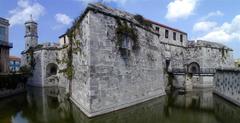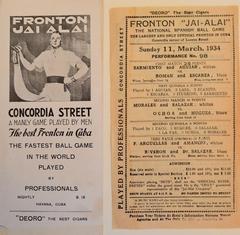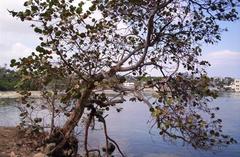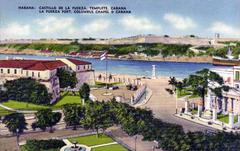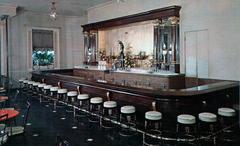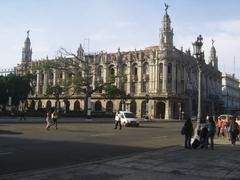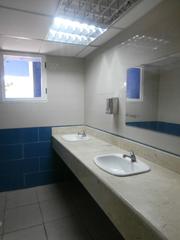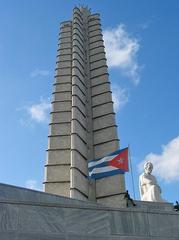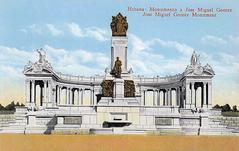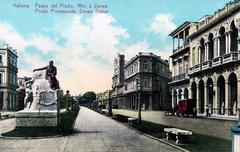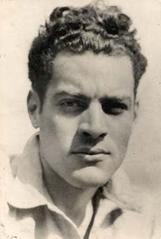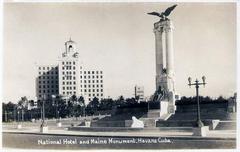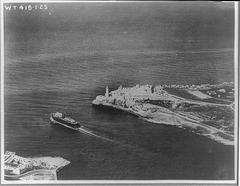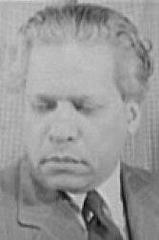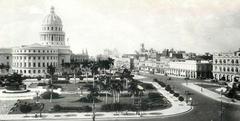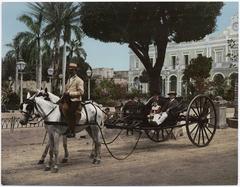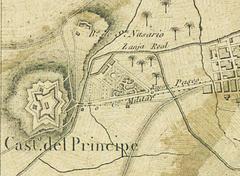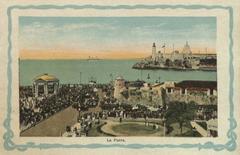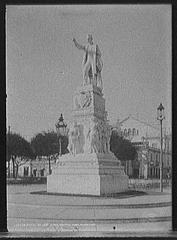
Teatro Amadeo Roldán: Visiting Hours, Tickets, and Havana Historical Sites Guide
Date: 04/07/2025
Introduction
Nestled in Havana’s vibrant Vedado district, the Teatro Amadeo Roldán is a monumental symbol of Cuba’s rich cultural and musical heritage. Since its 1928 inauguration (originally as Teatro Auditórium), the theater has been celebrated for its neoclassical architecture and world-class acoustics, attracting leading Cuban and international artists for nearly a century. Although currently closed due to structural deterioration, its legacy as a cultural beacon endures, representing Havana’s cosmopolitan spirit and dedication to the arts (Cubanet; Cuballama; CiberCuba).
This guide explores the theater’s storied history, architectural significance, practical visitor information, and the preservation challenges it faces. Whether planning a future visit or seeking to understand Havana’s cultural landscape, you’ll find essential insights about this landmark and recommendations for exploring nearby attractions.
Table of Contents
- Introduction
- Origins and Founding Vision
- Inauguration and Early Years (1928–1959)
- Post-Revolutionary Transformation (1959–1977)
- The 1977 Fire and Prolonged Closure
- Restoration and Rebirth (1999–2010)
- Recent Decline and Current Status (2010–2025)
- Architectural and Cultural Legacy
- Visitor Information
- Frequently Asked Questions (FAQ)
- Nearby Attractions
- Responsible Tourism and Preservation
- Visual Gallery
- Conclusion
- References
Origins and Founding Vision
Teatro Amadeo Roldán was conceived during a period of cultural flourishing in Havana’s early 20th century. María Teresa García Montes de Giberga, a renowned soprano and founder of the Sociedad Pro-Arte Musical (established in 1918), spearheaded the project to foster musical appreciation and guarantee high-quality concerts (Cubanet). By the mid-1920s, the society acquired land at Calzada and D streets in Vedado, and through an architectural competition, Miguel Ángel Moenck and Nicolás Quintana were chosen as designers (Ecured; D-Cuba).
Inauguration and Early Years (1928–1959)
Inaugurated on December 2, 1928, the theater became the most modern in Cuba, seating 2,500 and earning praise for its exceptional acoustics (Fotos de la Habana). It became the headquarters of Pro-Arte Musical, hosting a diverse range of performances—from symphonies and chamber music to opera and ballet. Luminaries such as Renata Tebaldi, Andrés Segovia, and Artur Rubinstein graced its stage (Ecured).
Post-Revolutionary Transformation (1959–1977)
After the Cuban Revolution, the theater was nationalized, renamed for pioneering Afro-Cuban composer Amadeo Roldán, and underwent significant renovations. Programming expanded to include both classical and popular Cuban genres, reflecting the government’s commitment to cultural accessibility (Wikipedia; Cubadebate).
The 1977 Fire and Prolonged Closure
A devastating fire in June 1977 destroyed much of the theater, leading to a closure that lasted over two decades (Wikipedia). The fire, believed to be sabotage, left a cultural void in Havana. Economic constraints and shifting priorities delayed restoration (Magazine AM:PM).
Restoration and Rebirth (1999–2010)
After extensive reconstruction, the theater reopened in 1999 with two principal halls: Amadeo Roldán Hall and Alejandro García Caturla Hall, each equipped with modern acoustics (D-Cuba; Wikipedia). It became home to the National Symphony Orchestra of Cuba and hosted prestigious events like the International Guitar Gathering (Wikipedia). Despite critiques over restoration quality, the venue resumed its role as a hub for classical and contemporary music (Cubadebate).
Recent Decline and Current Status (2010–2025)
By 2010, structural issues and lack of maintenance led to another closure. The building is now overtaken by vegetation, with interior decay and reports of squatters and vandalism (CiberCuba; Cuballama). In March 2025, a fire—attributed to vandalism—was quickly controlled, prompting the authorities to announce improved security measures (CiberCuba). However, no concrete restoration timeline has been established.
Architectural and Cultural Legacy
Teatro Amadeo Roldán’s neoclassical and eclectic design, with grand columns and elegant ornamentation, set a benchmark for performance venues in Cuba. Its legendary acoustics and versatile stage supported a wide range of performances, earning it a reputation as one of the country’s premier cultural institutions (Ecured; D-Cuba).
The theater played a pivotal role in promoting Cuban music, hosting historic performances and festivals such as the Havana International Jazz Festival (Havana Guide). Its affiliation with the Orquesta Sinfónica Nacional and support for music education further cemented its status.
Visitor Information
Visiting Hours
As of July 2025, Teatro Amadeo Roldán remains closed to the public. There are no current visiting hours or public access, and all interior tours are suspended due to safety concerns (Cuballama). Updates will be posted by Cuban cultural authorities and local news outlets.
Tickets
No tickets are available at this time as the theater is not operational. Historically, tickets were sold at the box office and through local contacts for performances and festivals. When restoration and reopening occur, advance booking is recommended due to high demand.
Location and Getting There
The theater is located at Calzada and D streets in Vedado, Havana, a central cultural district. It is accessible by taxi, public bus, or on foot from central Havana. The Vedado area is known for its lively atmosphere, historic architecture, and proximity to other major cultural sites.
Accessibility
Currently, the site is not accessible due to closure and safety risks. Previously, the venue included some accessibility features, but these are not guaranteed in its current state.
Guided Tours and Special Events
While interior guided tours are unavailable, several Vedado walking tours make exterior stops at the theater, providing historical context and architectural insights. Check with local tour operators for updated routes and information.
Photographic Spots
The theater’s neoclassical façade is best viewed and photographed from Calzada Street. Morning and late afternoon light highlight its architectural details.
Frequently Asked Questions (FAQ)
Q: Is the Teatro Amadeo Roldán open to visitors?
A: No, as of July 2025, the theater is closed due to safety and structural concerns.
Q: Can I buy tickets for performances or guided tours?
A: Tickets are not currently available. Interior tours are suspended until further notice.
Q: Is the theater accessible for people with disabilities?
A: The site is not currently accessible due to closure and safety issues.
Q: Are there guided tours of the theater?
A: Only exterior stops are included in some Vedado walking tours.
Q: How can I support preservation efforts?
A: Raise awareness through social media, engage with heritage organizations, and support local advocacy.
Nearby Attractions
While Teatro Amadeo Roldán is closed, visitors can explore other nearby sites, including:
- Gran Teatro de La Habana – A renowned venue for ballet and opera.
- Teatro Martí – Historic theater with regular performances.
- Capitolio Nacional and Parque Central – Iconic landmarks within walking distance.
- Malecón – Havana’s famous waterfront promenade.
These sites are operational and offer guided tours and live performances.
Responsible Tourism and Preservation
- Respect posted warnings and do not attempt to enter the closed theater.
- Support local guides and heritage preservation initiatives.
- Share information and images to raise awareness about the theater’s plight.
- Stay informed through official channels and consider verified contributions to restoration efforts.
Visual Gallery
View Map of Teatro Amadeo Roldán Location
Conclusion
Teatro Amadeo Roldán is an enduring symbol of Havana’s artistic resilience and musical innovation. From its golden age through periods of adversity and renewal, the theater’s influence on Cuban cultural identity is profound. While its doors remain closed, public advocacy and institutional awareness are essential for its preservation. Visitors are encouraged to appreciate its historical legacy from the exterior, explore the dynamic Vedado district, and support ongoing efforts to restore this musical jewel.
Stay informed about restoration progress and Havana’s cultural events by following official sources, downloading the Audiala app, and engaging with the city’s vibrant arts scene. Preserving Teatro Amadeo Roldán honors Cuba’s past and inspires future generations.
References
- Amadeo Roldán Theatre – Wikipedia
- Teatro Amadeo Roldán – Ecured
- Teatro Amadeo Roldán: History and Restoration – Cubanet
- Teatro Amadeo Roldán Closure and Preservation – CiberCuba
- Recent Fire and Security Measures – CiberCuba
- Teatro Amadeo Roldán History – Magazine AM:PM
- Teatro Amadeo Roldán Visitor Information – Cuballama
- Restoration and Reopening – D-Cuba
- Havana International Jazz Festival – Havana Guide
- Cultural Events at Teatro Amadeo Roldán – Cubadebate
- History of Teatro Amadeo Roldán and Pro-Arte Musical – Cubadebate


